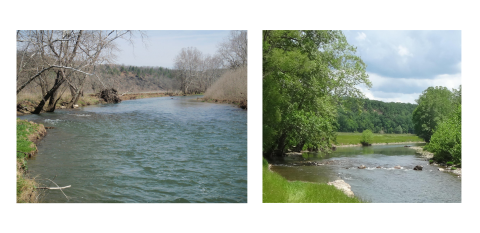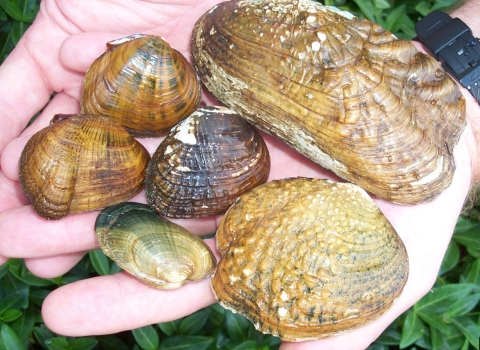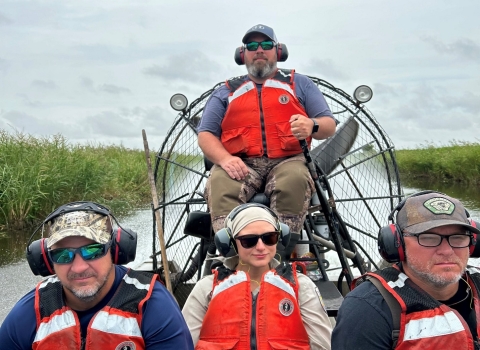James spinymussels have been protected under the Endangered Species Act since 1988. Loss of habitat and water quality issues stemming from industrial and municipal discharges and runoff from towns and farms lead to the aptly-named bivalve disappearing from nearly 95% of its historic range. Small remnant populations remained in the upper reaches of the James River watershed in West Virginia and Virginia and in parts of the Dan River watershed in North Carolina near the Virginia border.
To help recover the species, the Service recommended protecting the habitat of existing populations, restoring habitat to help populations recolonize those places where they had been eliminated, and using the newly developed tool of propagating mussels in hatcheries to reestablish populations within its historical range. Here is where the road to recovery runs through the Harrison Lake National Fish Hatchery, taking advantage of the expertise of hatchery manager Rachel Mair and Brian Watson with the Virginia Department of Wildlife Resources (DWR).
A Recovery Recipe for Success
In 2007, the hatchery partnered with the Virginia DWR to establish the Virginia Fisheries and Aquatic Wildlife Center at the hatchery. Their mission – restore species of freshwater mussels that were disappearing from Atlantic slope rivers, especially federally endangered species like the James spinymussel.
Mair was the first to propagate James spinymussels and release them back into the wild in 2013. Her careful techniques for infesting small host fish like the rosyside dace and for improving the feeding and care of rare mussels have made the recovery program at the Harrison Lake NFH and VFAWC successful.
Since 2017, the interagency team has propagated and stocked more than 3000 spinymussels into eight different populations in the James River and Dan River watersheds, expanding the size of existing populations and helping reestablish new populations.
The team reached a MAJOR milestone in the recovery of the James spinymussel in 2022 when they stocked spinymussels back into the mainstem of the James River – where the species hadn’t been seen for over 60 years.
Biologists tagged about 1,300 mussels with a unique number so they can monitor the population’s recovery in the coming years. Half of those released into the James River (650) also received a passive integrated transponder (PIT) tag that can be detected by a special antennae or PIT tag reader. Biologists will search for mussels following the “pings” detected by the reader in the coming years, and then they will snorkel or dive to find more mussels. They will evaluate survival, growth, and whether the mussels are reproducing.
The Importance of Habitat
Our recipe for recovery also includes restoring places for the species to thrive. Following the recommendations in the James spinymussel Recovery plan, the Service has been working for over a decade with a suite of partners to protect and restore habitats in the James River watershed.
The Service’s Appalachian Fish and Wildlife Conservation Office, a private landowner, and the West Virginia Land Trust recently came together to protect and restore lands surrounding a healthy population of James spinymussel in the headwaters of the James River, which are key to the species recovery.
The Virginia Ecological Services Field Office worked with landowners and the Fish America Foundation to restore floodplain habitat, and reduce erosion and sedimentation into the Cowpasture River, an important stronghold for the James spinymussel.
Dam removals help mussels too. The Virginia Fish and Wildlife Conservation Office and the Virginia DWR worked with the owner of the Jordan Point Dam and the City of Lexington to restore river flows and habitat in the Maury River, a tributary to the James River. The dam removal has improved the distribution of sediments through the river, created better habitat for fish and mussels downstream, and has allowed fish (and their hitch-hiking mussels) to recolonize upstream of the former dam, while also improving public safety and reducing impacts of flooding.
“What we’ve been seeing with freshwater mussels in the James River primarily from Lynchburg downstream to about Richmond, has given us an indication that conditions are good for the reintroduction of rare species like the James spinymussel,” says Watson, Virginia DWR.
“If the causes of harm and degradation are removed, the environment can heal as long as the seeds for getting started are still there” he adds. “In the case of freshwater mussels with their complicated life cycle, it would take decades for a bed of mussels to rebuild itself. That’s why they need a little assistance to jumpstart the process and boost their numbers.”
The Clean Water Act of 1972 and ongoing habitat restoration efforts by numerous landowners and organizations have all played key roles in helping improve water quality and habitat in the James River. The Harrison Lake NFH and Virginia Fisheries and Aquatic Wildlife Center staff are stocking freshwater mussels into these restored habitats.
“To date we have released around 320,000 mussels into rivers that feed into the Chesapeake Bay and Albemarle Sound”, says Mair, “It’s very gratifying to see our mussel conservation and restoration efforts are working, not only for the James spinymussel, but for the other dozen species we are raising to restore both species and the services mussels provide.”
Mussels Matter
As we lose mussels, we lose the valuable ecoservices they provide, like filtering water. Propagation and stocking of freshwater mussels, in connection with restoring habitat, and better land practices can help us recover endangered species, prevent the listing of additional species of mussels, and restore health and water quality to our rivers.









